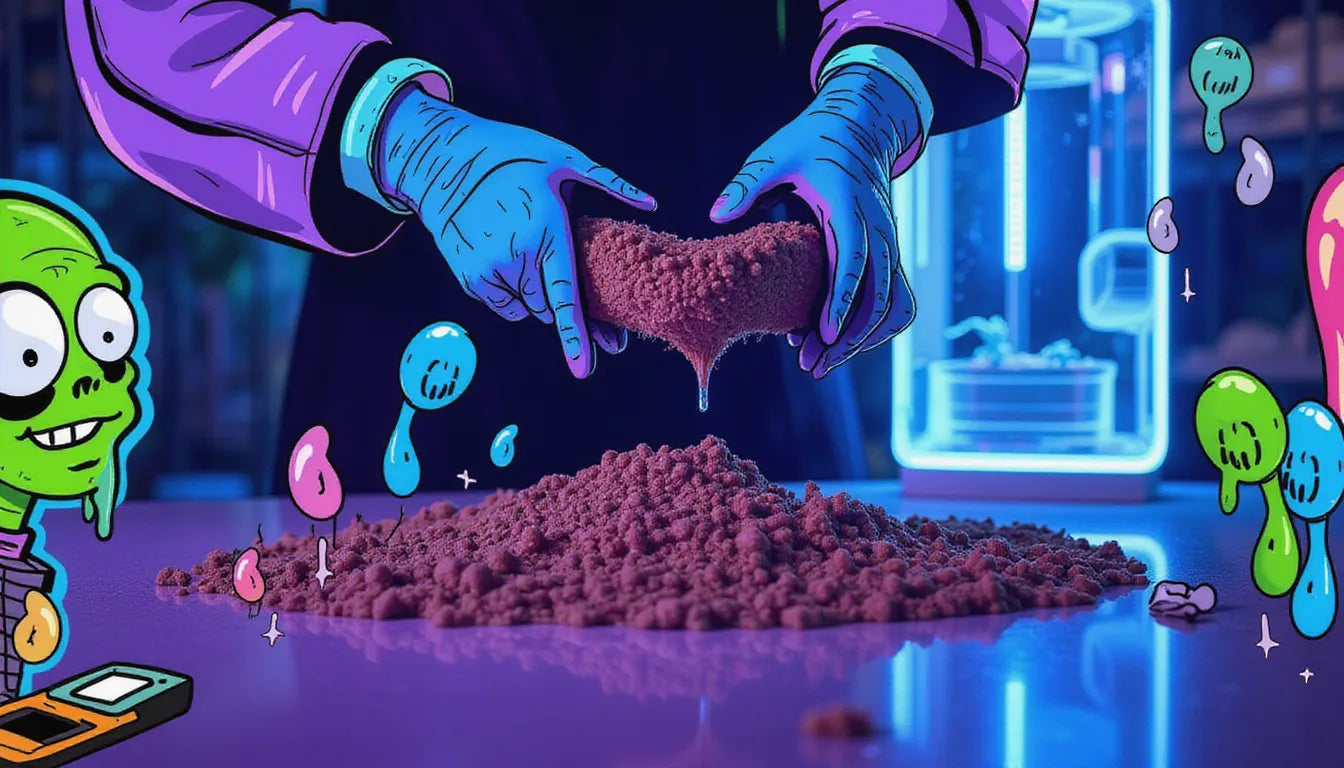⬇️ Prefer to listen instead? ⬇️
- 💧 Substrate moisture content between 55–65% is optimal for mycelium growth based on substrate type.
- 🍄 Oyster mushrooms tolerate wetter substrates, while Lion’s Mane prefers tighter moisture control.
- 🧪 The squeeze test remains a reliable field check for moisture despite its subjectivity.
- ⚠️ Overhydration invites pathogens like Trichoderma, sinking overall yield and colonization success.
- 📊 Using kitchen scales for dry-to-wet ratios improves precision in DIY mushroom cultivation setups.
If your mushrooms aren’t growing pins well or colonization seems slow, substrate moisture could be the reason. Field capacity is how much water your substrate can hold before it's too wet. This is very important for good mycelium growth, keeping contamination away, and getting solid harvests. Whether you use jars, monotubs, or large spawn bags, having the right amount of water makes a big difference in your mushroom grow. Using our ready-made mushroom substrates means you don’t have to worry about hitting the perfect field capacity—they’re already hydrated and balanced, giving you more reliable colonization and faster pinning without the extra work
Why Moisture Balance Matters for Mycelium Growth
Mycelium is the main part of the fungus that grows. It needs a good balance of air and water to do well. Water helps cells work, and oxygen is needed for them to breathe and stay healthy. If the substrate moisture is not right, this balance breaks down.
When substrates are too wet, water fills the air pockets that usually provide oxygen. Without oxygen, there is no air, and this makes it easy for contamination to start. Things like Trichoderma (green mold) and different bacteria can take over. This causes sour smells and often means the grow fails.
On the other hand, not enough water slows down how the mycelium works. Mycelium needs nutrients that are in water to grow. A dry substrate doesn't help mycelial growth. Instead of growing everywhere evenly, the mycelium might stop or miss parts completely. Sometimes, colonization fails completely.
Getting the right moisture level is a very important step that many people miss. It's key for growing mushrooms well every time.

Physically Testing for Field Capacity (The Squeeze Test)
The squeeze test is an easy and old method to check substrate moisture. Some say it's not accurate because it's based on feeling. But if you do it right, it works and is simple.
How to Perform the Squeeze Test
- Take a large handful of your fully mixed substrate.
- Squeeze it tightly in a clenched fist.
- Observe the results:
- Too Dry: No water drips and the material feels dusty or crumbles.
- Too Wet: Water runs or streams out of your hand.
- Just Right: One to two drops emerge slowly, and the mixture feels like a damp, wrung-out sponge.
This test works best with fibrous or loose substrates like straw, coir, and sawdust. For mixes with a lot of grain, where water is inside the grain, other ways to dry or measure water after adding it might work better.
The squeeze test is simple, so growers at any level can check moisture without needing costly tools. And if you do it often, you get to know how your substrate feels and reacts to water.

Ways to Measure Substrate Moisture More Accurately
While methods based on feeling work, growers who want more exact results might use tools to measure moisture. Different substrates hold and let go of water differently, so the best moisture content is usually given as a percentage of the substrate's weight.
Below are numbers based on common substrate types:
| Substrate Type | Ideal Moisture Content (%) |
|---|---|
| Coco Coir + Vermiculite | 60–65% |
| Hardwood Sawdust | 55–60% |
| Straw | 65–70% |
| Grains (Rye, Millet) | Varies (hydrated internally) |
These percentages are based on field research and widely accepted cultivation formulas.
For example, if you have 1,000 grams of dry coir, adding 650 grams of water makes it about 65% moisture. This method gives you a clear goal. It is also very useful when making bigger batches or making sure all batches are the same.

Impact of Improper Moisture: What Can Go Wrong
Getting moisture wrong can cause serious problems later in your grow. Let’s look at the common issues:
Overhydrated Substrate:
- Helps bad things grow (like Trichoderma, Bacillus).
- Stops oxygen, which chokes the mycelium as it tries to grow.
- Creates wet pockets where contamination hides.
- Takes longer to colonize, sometimes never finishes.
Underhydrated Substrate:
- Causes colonization to be uneven or stop.
- Can cause the substrate to shrink and crack.
- Makes mycelium avoid dry spots.
- Leads to weak fruiting or pins that stop growing.
These effects might not show up until colonization is well along, or even when fruits are forming. So it's very important to test early and often. Moisture errors made at the start are hard to fix later, and often costly.

Understanding Moisture by Substrate Type
How much water each substrate can hold and release is different. Knowing this is key to getting field capacity just right.
Coco Coir + Vermiculite
- Holds water very well and has good air.
- Field capacity: 60–65%
- Good for bulk substrates and beginner kits.
Hardwood Sawdust
- Denser, less airy — takes in and holds water steadily.
- Field capacity: around 55–60%
- Used often for gourmet kinds (e.g., Shiitake, Lion's Mane).
Straw
- Hollow stems don’t hold water well.
- Field capacity: 65–70%
- Must be pasteurized carefully to kill bad things while getting fully wet.
Grains (Rye, Millet, Wheat Berries)
- Water inside the grain is key — they should feel dry outside but be soaked inside.
- Good moisture = slightly soft, not mushy.
- How long you boil and simmer them affects how much water they hold.
Knowing these things helps you treat each substrate the right way. And it means less trying things out to get it right each time.

Moisture-Tolerant vs. Sensitive Mushroom Species
Not all mushrooms react the same way to changes in moisture.
Moisture-Tolerant:
- Oyster (Pleurotus spp.): Does well in high humidity; handles wet substrates well; colonizes fast.
- Enoki: Light and fast-growing; does well with slightly wetter mixes.
Moisture-Sensitive:
- Lion’s Mane (Hericium erinaceus): Doesn't like water pooling; likes moisture that is not too much and stays the same.
- Shiitake (Lentinula edodes): Needs certain times for soaking and drying; too much water makes them form slower.
Changing your substrate moisture for each type of mushroom helps you get healthier and bigger harvests. This is very true when growing exotic or gourmet kinds.

Tools to Measure Substrate Moisture Consistently
While methods based on feeling work, growers who want more exact results might use tools to measure moisture. This is especially true when growing a lot or wanting the same results every time.
Popular Tools Include:
- Digital Moisture Meters: These give percentages right away based on how well electricity passes through. Best used on fibrous substrates like straw or coir.
- Kitchen Scales + Weighing Method: Figure out the weight when dry compared to the weight when wet. (e.g., 500g dry substrate + 300g water = 60% field capacity).
- Moisture Balances: Lab tools for very accurate testing. But they are often too expensive for small to medium growers.
Using one or more of these tools makes things easier across many tubs or bags. This is especially true when growing different types or batches one after another.

How to Fix Moisture When It's Not Right
You've prepared your mix and see it’s too wet or bone dry. Don’t panic — you can fix it.
If Too Wet:
- Spread the substrate on a clean tray.
- Let it air dry for 30–60 minutes.
- Stir every 10 minutes to help it dry evenly.
- Check it again with the squeeze test.
If Too Dry:
- Use a spray bottle or pour water slowly.
- Add water in small amounts (10ml per kg at a time).
- Mix it well so there are no wet spots.
- Mix in a little wet substrate (if you have some).
Pro tip: Always add water before sterilizing or pasteurizing. Changing moisture after treatment can cause contamination.

Signs Your Substrate Moisture Is Not Right
Seeing moisture problems early can save your whole grow. Look for:
- Colonization stopping partway through: Often means there are dry spots.
- Bad or sour smell: Shows there is too much water and bacteria.
- Uneven growth speed in a tub or bag: Moisture is not spread evenly.
- Water pooling on top or water drops inside the bag: Probably too wet and doesn't have enough air.
These signs tell you something is wrong. Checking often during the first 7–14 days after you inoculate helps get things right again.

Moisture at Different Stages of Growing
Each part of growing needs different moisture levels:
1. Inoculation:
Moisture must be spread evenly so the spawn sticks and the mycelium can take over.
2. Colonization:
Field capacity needs to stay steady. If moisture changes because of bad sealing or air flow, it will stop colonization.
3. Fruiting:
No need to change substrate moisture here. Instead, focus on the humidity in the air (85–95%) by misting, using foggers, or spraying by hand.
Knowing how moisture helps at each stage lets you figure out problems smartly instead of just guessing.

How to Get the Right Moisture Every Time for Spawn Bags & Kits
With DIY setups, getting the same results every time is the hardest part. Here's how to make sure it's right every time:
- Add water and mix very well before packing bags.
- Grab handfuls from different parts of the container to check it.
- Don't pack the substrate down too hard — air still needs to get through.
- Sterilize or pasteurize carefully so it seals well and moisture doesn't escape.
Kits you buy are often measured out and watered just right by experts. New growers or those short on time like how easy this makes it.

Common Mistakes and Wrong Ideas About Moisture
Learning the truth about common myths helps you grow better:
- “Wetter is better.” No, too much water stops air getting through and kills growth.
- “Squeeze test is just guessing.” If you practice, it works well and you get a feel for it.
- “Distilled water improves results.” Not true. Any clean water works fine; the amount of water compared to substrate is what matters.
Understanding these wrong ideas lets growers focus on how they do things instead of just buying tools.

Tips for Growing More and Still Getting it Right
Whether you have five tubs or 500 bags, watering large amounts can still be done if you are careful.
- Check a sample from each batch: Grab one handful from every 10 pounds and squeeze it.
- Label everything: Use tags or lists to write down how much water you added to each batch.
- Use automatic systems if you can: Use systems that add water on a timer for bigger grows.
Getting moisture wrong when growing a lot quickly wastes time, money, and weeks you could have gotten fruit.

Moisture Is as Important as Sterility
Getting field capacity just right is not just nice to have, it's needed. Just like sterilizing, controlling substrate water decides what will grow: your mushrooms or bad contamination. And unlike other things in growing, the right amount of water affects how things go and what you get, from inoculation to harvest.
Take the time to get it right and learn by trying things carefully. Your harvests will be bigger, more even, and stronger. For true beginners, kits like those from Zombie Mushrooms offer substrates with the exact right moisture so you can focus on fruiting, not fixing problems.





